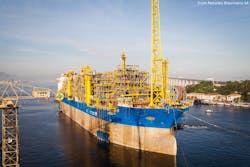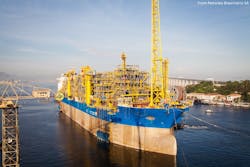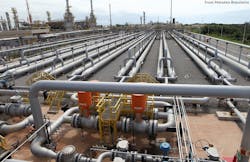Cidade de Marica FPSO, Rota 2 gas line begin operations from Santos basin
Petroleo Brasilierio SA (Petrobras) reported the startup of the Cidade de Marica floating production, storage, and offloading vessel, and the Rota 2 subsea gas pipeline, both from the presalt Santos basin.
The Cidade de Marica FPSO arrived in December at the Lula Alto area of Lula field, where it’s anchored 250 km off Rio de Janeiro in 2,120 m of water (OGJ Online, Dec. 28, 2015).
Now the seventh FPSO operating in the Santos basin, the 346.5-m-long, 32.6-m-high unit can produce 150,000 b/d of oil, store 1.6 million bbl of oil, and compress 6 million cu m/day of gas.
The first four Santos FPSOs, installed during 2010-14, remain producing at almost full capacity of 475,000 b/d of oil via 19 production wells. The three most recent units are producing at 205,000 b/d with seven production wells.
The six Santos FPSOs already operating:
• Cidade de Angra dos Reis from the Lula field pilot during October 2010 (OGJ Online, Oct. 28, 2010).
• Cidade de Sao Paulo from the Sapinhoa field pilot during January 2013.
• Cidade de Paraty from Lula Northeast during June 2013.
• Cidade de Mangaratiba from the Iracema South area of Lula during October 2014 (OGJ Online, Aug. 18, 2014).
• Cidade de Ilhabela from Sapinhoa North in November 2014 (OGJ Online, Nov. 21, 2014).
• Cidade de Itaguai from the Iracema North area of Lula in July 2015 (OGJ Online, Aug. 3, 2015).
During 2016, two more FPSOs are expected to begin producing: the Cidade de Saquarema as part of the Central Lula project (OGJ Online, Dec. 22, 2015); and Cidade de Caraguatatuba as part of the Lapa project.
Petrobras says the Santos and Campos presalt now accounts for 35% of Brazilian oil output.
The Lula Alto and Central Lula areas are owned by the BM-S-11 consortium, operated by Petrobras with 65% interest in partnership with BG E&P Brasil Ltda. 25% and Petrogal Brasil SA 10%.
Sapinhoa and Lapa fields are in concession BM-S-9, operated by Petrobras with 45% interest in partnership with BG E&P Brasil 30% and Repsol Sinopec Brasil SA 25%.
Rota 2 subsea line
Petrobras on Feb. 12 began operation of the 401-km, 13 million-cu m/day Rota 2 subsea gas pipeline, which connects Santos basin production systems with the newly expanded, 28.4 million-cu m/day Cabiunas gas treatment terminal in Macae, Rio de Janeiro.
Rota 2 will be connected to the 359-km, 10 million-cu m/day Rota 1 operating since September 2011 (OGJ Online, Sept. 20, 2011).
The Cernambi-Tecab pipeline is owned by the Cabiunas 1 consortium, operated by Petrobras with 55% interest. Partners are BG E&P Brasil 25%, Repsol Sinopec Brasil 10%, and Petrogal Brasil 10%.


